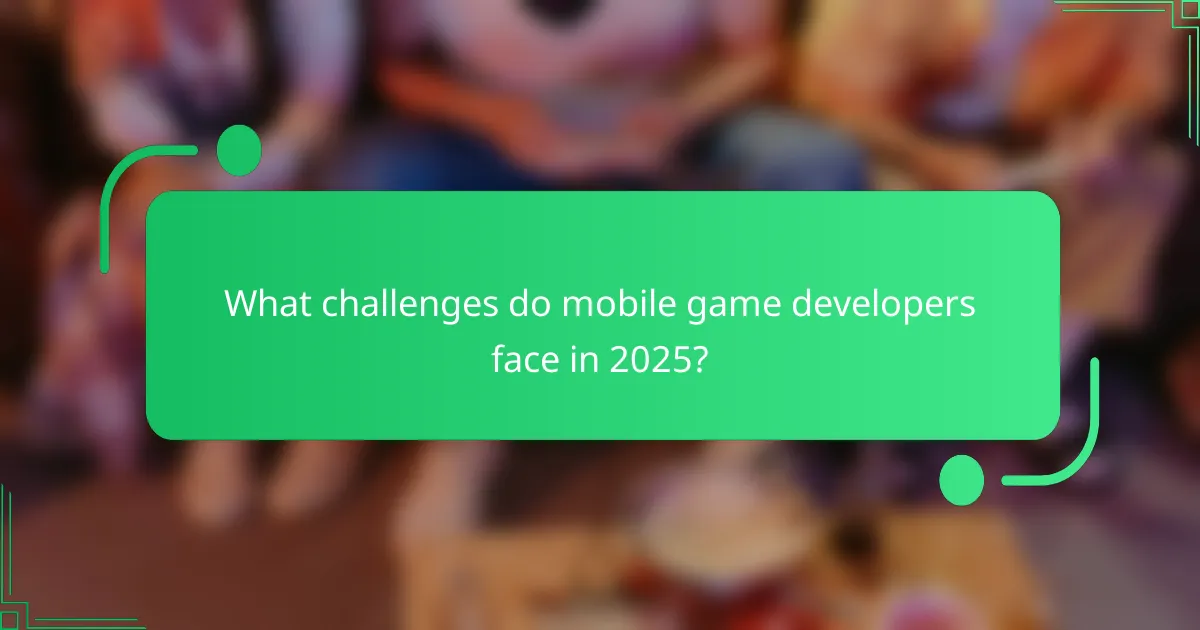Mobile gaming is rapidly evolving, influenced by technological advancements and shifting player preferences. Key trends include the rise of cloud gaming, the popularity of hyper-casual games, and the integration of augmented and virtual reality. Anticipated titles in 2025 showcase innovative gameplay and immersive storytelling, while market dynamics highlight the growing importance of subscription models and cross-platform play. Developers face challenges such as intense competition and the need for continuous innovation to meet evolving expectations.

What are the key trends shaping mobile gaming in 2025?
Mobile gaming in 2025 will be shaped by advancements in technology, evolving player preferences, and market dynamics. Key trends include the rise of cloud gaming, enhanced graphics through AR and VR, and the popularity of hyper-casual games.
Cloud gaming will enable seamless access to high-quality games on various devices, enhancing user experience. Augmented reality and virtual reality will provide immersive gameplay, attracting a broader audience. Hyper-casual games will continue to dominate due to their accessibility and engaging mechanics, appealing to casual gamers.
Additionally, the integration of AI in game design will personalize experiences and improve player retention. Subscription models will gain traction, allowing players to access a wide range of games for a fixed fee, reflecting changing consumer behaviour in digital content consumption.
How are emerging titles influencing player engagement?
Emerging titles significantly enhance player engagement by introducing innovative gameplay mechanics and immersive narratives. These games often leverage cutting-edge technology, such as augmented reality or advanced graphics, to create captivating experiences. For example, the rise of hyper-casual games has attracted a broader audience, increasing session times and retention rates. As a result, developers focus on user feedback to refine game features, ensuring sustained interest and engagement.
Which popular genres are dominating the mobile gaming market?
Action-adventure, role-playing games, and casual puzzle games are dominating the mobile gaming market. Action-adventure titles engage players with immersive storytelling and dynamic gameplay. Role-playing games attract users with character development and intricate worlds. Casual puzzle games appeal to a broad audience due to their accessibility and quick play sessions. These genres reflect current consumer preferences, driving market growth and innovation.

What factors are driving market dynamics in mobile gaming?
Mobile gaming market dynamics are driven by evolving player preferences, technological advancements, and competitive strategies. The rise of multiplayer experiences and cross-platform play enhances engagement. Additionally, the integration of augmented reality and virtual reality creates immersive environments, attracting new users. In-app purchases and subscription models are reshaping revenue streams, influencing game development trends.
How does user behaviour vary across different regions?
User behaviour in mobile gaming varies significantly across regions due to cultural preferences and economic factors. For instance, Asian markets often favour multiplayer online battle arena games, while Western regions lean towards casual and narrative-driven titles.
In North America, mobile gamers typically engage with action and adventure genres, reflecting a preference for immersive experiences. Conversely, in Europe, puzzle and strategy games dominate, highlighting a trend for cognitive challenges.
Emerging titles often adapt to regional tastes, with localised content enhancing user engagement. Market dynamics indicate that understanding these behavioural trends is crucial for developers aiming to succeed globally.
Which platforms are preferred for mobile gaming in various markets?
Mobile gaming platforms vary by market preferences, with key choices including Android, iOS, and specific regional services. In North America, iOS leads due to premium titles, while Android dominates globally with diverse offerings. In Asia, platforms like Tencent’s WeChat Games are popular, reflecting local preferences. Emerging markets favour low-cost Android devices, enhancing accessibility to mobile gaming.

What are the most anticipated mobile game releases of 2025?
The most anticipated mobile game releases of 2025 include titles that reflect key trends in gameplay and market dynamics. Notable genres expected to dominate are action-adventure, role-playing, and multiplayer online battle arenas. Upcoming titles such as “Elysium Chronicles,” “Galactic Frontiers,” and “Mystic Realms” showcase innovative gameplay mechanics and immersive storytelling. Market dynamics indicate a growing demand for cross-platform play and augmented reality features, enhancing user engagement.
How are indie developers contributing to the mobile gaming landscape?
Indie developers are significantly shaping the mobile gaming landscape by introducing innovative gameplay and unique narratives. Their focus on niche genres has led to the emergence of diverse titles that cater to varied player preferences.
Many indie games emphasize creativity and experimentation, often resulting in fresh mechanics and artistic styles. For instance, titles like “Stardew Valley” and “Among Us” have gained immense popularity by offering engaging experiences that differ from mainstream options.
Additionally, indie developers frequently leverage platforms like Steam and mobile app stores to reach broader audiences. This accessibility fosters a competitive environment, driving larger studios to innovate and adapt to changing player expectations.
Indie contributions also enhance market dynamics by encouraging community involvement and feedback, leading to iterative development and ongoing support. This collaborative approach helps sustain player interest and loyalty over time.
What role do major franchises play in mobile game popularity?
Major franchises significantly boost mobile game popularity through established fan bases and recognisable brands. Their marketing power and cross-platform integration enhance visibility and engagement. Franchises like Pokémon and Call of Duty leverage nostalgia and community, driving downloads and in-game purchases. This phenomenon illustrates how brand loyalty translates into mobile gaming success.

How is monetisation evolving in mobile gaming?
Monetisation in mobile gaming is evolving through innovative strategies and diverse revenue streams. Developers increasingly focus on in-game purchases, subscription models, and advertisements. The rise of free-to-play games has shifted the market dynamics, emphasising player engagement and retention. Unique attributes like personalised experiences and cross-platform compatibility enhance monetisation potential. As a result, emerging titles often leverage these trends to maximise revenue while maintaining user satisfaction.
What are the most effective monetisation strategies for mobile games?
The most effective monetisation strategies for mobile games include in-app purchases, advertisements, and subscription models. In-app purchases allow players to buy virtual goods, enhancing gameplay. Advertisements generate revenue through ad placements during gameplay. Subscription models provide a steady income stream by offering premium content or features for a recurring fee. Each strategy targets user engagement and maximises revenue potential.
How do in-app purchases impact player retention?
In-app purchases significantly enhance player retention by providing ongoing engagement and personalised experiences. Players often feel incentivised to return for exclusive content or upgrades, leading to increased loyalty. Games that effectively implement in-app purchases can see retention rates rise by up to 30%. This strategy fosters a sense of progression and achievement, encouraging players to invest more time and money into the game. Additionally, the allure of new features or limited-time offers can drive players back into the game, reinforcing their commitment and enjoyment.

What are the technological advancements influencing mobile gaming?
Technological advancements like cloud gaming, augmented reality, and 5G connectivity are significantly influencing mobile gaming. These innovations enhance user experiences and expand gameplay possibilities.
Cloud gaming allows players to access high-quality games without needing powerful hardware. Augmented reality creates immersive environments, blending real and virtual worlds. The rollout of 5G networks offers faster download speeds and reduced latency, improving multiplayer experiences.
Additionally, AI-driven algorithms personalise gameplay, adapting to individual player preferences. Cross-platform capabilities enable seamless transitions between devices, fostering a more unified gaming experience. These trends shape the future of mobile gaming, driving engagement and market growth.
How is augmented reality changing the gaming experience?
Augmented reality is transforming gaming by enhancing immersion and interaction. Players experience real-world environments integrated with digital elements, creating a unique gameplay dynamic. This technology fosters social engagement and competition, as seen in titles like Pokémon GO. Additionally, augmented reality encourages innovative game design, leading to emerging genres that blend physical and virtual experiences. As a result, the gaming market is evolving, attracting diverse audiences and increasing revenue potential.
Which innovations are enhancing gameplay and graphics?
Innovations enhancing gameplay and graphics include advanced graphics engines, augmented reality features, and artificial intelligence. These technologies improve visual fidelity, create immersive experiences, and enable dynamic game environments. Enhanced user interfaces and cloud gaming also contribute significantly to player engagement.

What challenges do mobile game developers face in 2025?
Mobile game developers face significant challenges in 2025, including intense market competition, evolving player expectations, and technological advancements. Developers must adapt to new platforms and devices, which require continuous innovation.
The rise of cloud gaming impacts game design, as developers need to ensure compatibility across various systems. Additionally, monetisation strategies are evolving, with a shift towards subscription models and in-game purchases.
Data privacy regulations present another challenge, as developers must navigate compliance while maintaining user trust. Finally, the demand for immersive experiences through augmented and virtual reality requires substantial investment and expertise.
How are regulatory changes affecting game development?
Regulatory changes are reshaping game development by introducing new compliance requirements and influencing market dynamics. Developers must adapt to evolving laws regarding data privacy, monetisation practices, and age ratings, which affect game design and distribution. For instance, stricter data regulations may limit how developers collect user information, impacting personalisation strategies. Additionally, these changes can create barriers for entry, particularly for smaller studios, while also fostering innovation as companies seek compliant alternatives. Overall, regulatory shifts drive a more responsible gaming environment, balancing player protection with industry growth.
What common pitfalls should developers avoid?
Developers should avoid common pitfalls like neglecting user experience, underestimating market research, and failing to optimise for performance. Prioritising engaging gameplay and clear monetisation strategies is crucial.
1. Ignoring User Feedback: Not incorporating player feedback can lead to poor retention rates.
2. Overcomplicating Mechanics: Complex controls can frustrate players, leading to negative reviews.
3. Underestimating Competition: Failing to analyse competitors can result in missed opportunities.
4. Skipping Testing: Insufficient testing can lead to bugs that harm user experience.
What best practices can enhance user experience in mobile games?
To enhance user experience in mobile games, developers should prioritise intuitive controls, engaging storytelling, and social interaction features. These elements foster deeper player engagement and satisfaction.
Optimising loading times significantly improves user retention. Research indicates that 53% of mobile users abandon games that take over three seconds to load.
Incorporating adaptive difficulty levels can cater to both novice and experienced players, ensuring a balanced challenge. This approach enhances player enjoyment and prolongs game longevity.
Regular updates with fresh content keep the gaming experience dynamic, encouraging players to return. Games that consistently introduce new features or events see increased user engagement and community growth.



